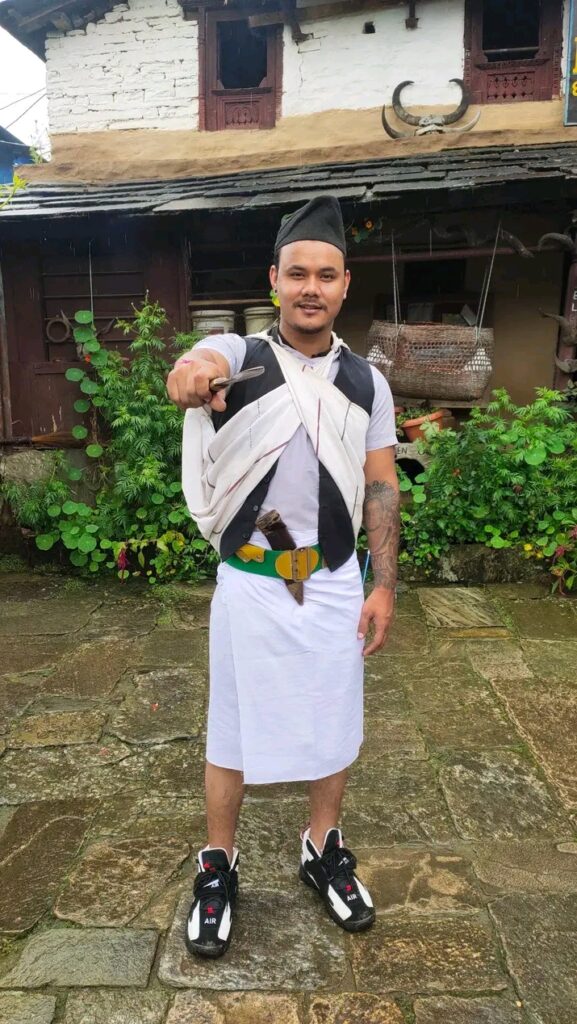Introduction To Gurungs
The Gurung people—also known as Tamu—are one of the major indigenous ethnic groups of Nepal. With a rich history, distinct traditions, and a strong sense of identity, the Gurung community plays a vital role in shaping the cultural and social fabric of Nepal. From their settlement in the Himalayan foothills to their reputation as brave warriors serving in the famous Gurkha regiments, the Gurungs embody resilience, unity, and cultural pride.
In this article, we will explore the origin, culture, lifestyle, festivals, occupations, and modern challenges of the Gurung people, while highlighting their contribution to Nepal and the global diaspora.
Table of Contents
History of Gurungs
It is believed that the Gurung People migrated from Tibet to Nepal around the 6th century before Buddhism spread in Tibet. Therefore their religion combines both Animistic rituals and Buddhist beliefs. Their history is uncertain due to the lack of written script, as their generations are handed down orally from generation to generation. During the 15th century, a Gurung king named “Gale Raja” was overthrown by then Nepali kings. During the 16th century, the khas armies took over and Gurung was under their control. later they helped the shah kings to unify Nepal.
Traditionally, Gurungs inhabit the mid-hills of the Annapurna region, which provides them with a unique lifestyle adapted to mountain agriculture and pastoralism. Many Gurung villages are located along trekking routes such as the Annapurna Circuit and Annapurna Base Camp, making them central to Nepal’s tourism and cultural showcase.
In the 19th century, Nepali Government signed a sugauli treaty allowing the British army to recruit Nepalese youth. Along with Magars and other natives of hills like Gurung, Rai, and Limbu were recruited into the British army. The recruitment of them is still prevalent in the British army.
Religion
Their ancients followed Bon Lama (a kind of Shamanism), Paju(Pachyu), and Ghyabri(Ghyabring). Later converted to Tibetan Buddhism and Hinduism. Today, Gurungs follow a mix of Buddhism, Hinduism, and their primitive religion.
Language of Gurung People
The Gurung language, also known as Tamu Kyi, belongs to the Tibeto-Burman family. While the younger generation often speaks Nepali and English due to education and globalization, Tamu Kyi remains a crucial part of Gurung identity. Efforts are being made by cultural organizations to preserve and promote the language through literature, media, and local education programs.
Culture and Traditions
In Gurung tradition, they celebrate so many festivals and ceremonies in different seasons of the year. Among these, Tamu Lhosar is one of the main celebrations. It falls every year in January. It is also a New year for Gurung People. Family and relatives gather to celebrate. various cultural events are organized, where people can be seen in their traditional attires. Other celebrations include Buddha Jayanti.
The Gurungs have a rich tradition of culture, dances, and music. They have a tradition of Rodhi where people( especially youth) meet, sing, and dance to traditional folk songs to share their views in the form of Dohori. Dance like Ghantu and Chadka are still in practice in most of the Gurung’s villages. These dances are performed either in groups or solo. Music also plays a vital role in the Gurung’s rituals of Argun, which are performed when someone dies in the community.
Gurung Dress
Both males and females have unique costumes, styles, and ornaments. Their costumes are somewhat similar to the Magar community but not all. They generally wear their traditional dress during events, various celebrations, and functions.
Gurung Dress for male
Components of Gurungmale dress
- Dhaka toti (Black)
- Bhoto/Vest
- Bakkhu
- Khachhad
- Bhangra
- Esta Coat ( waistcoat)
- Malaya/Sikgapuri Belt

Gurung female Dress
Components of Gurung female dress and ornaments
- Cholo
- Patuka
- lungi Mugiya
- Ghalek
- Pachari(white)
- Tikis
- Dhugri
- Jantar
- Naugedi
- Rings
Livelihood
Historically, Gurungs were engaged in pastoralism, agriculture, and sheep herding. Many still rely on subsistence farming of maize, millet, barley, and potatoes. However, a significant number of Gurungs are renowned for their service in the British and Indian Gurkha regiments, earning them a reputation as brave and loyal warriors.
Today, many Gurungs are engaged in:
- Tourism and hospitality (due to settlements in trekking regions)
- Foreign employment (Middle East, UK, Hong Kong, and beyond)
- Entrepreneurship and trade
Challenges Faced by Gurung People
Despite their rich heritage, the Gurung people face modern challenges such as:
- Cultural assimilation and loss of language among younger generations.
- Economic migration, leading to depopulation of villages.
- Struggles for political recognition and rights as an indigenous community in Nepal.
Several Gurung organizations are actively working to preserve their cultural heritage, promote education, and ensure political representation.
Conclusion
The Gurung people of Nepal are a proud indigenous community with a unique blend of traditions, history, and resilience. From their ancestral roots in the Himalayas to their global presence today, Gurungs continue to balance modern life with cultural preservation.
As Nepal develops and globalization expands, the importance of preserving Gurung language, rituals, and festivals becomes even more crucial. Recognizing and celebrating the Gurung people is not only about honoring a single community but also about appreciating Nepal’s rich cultural diversity.
Also check: https://insightsnp.com/about-tamangs/




